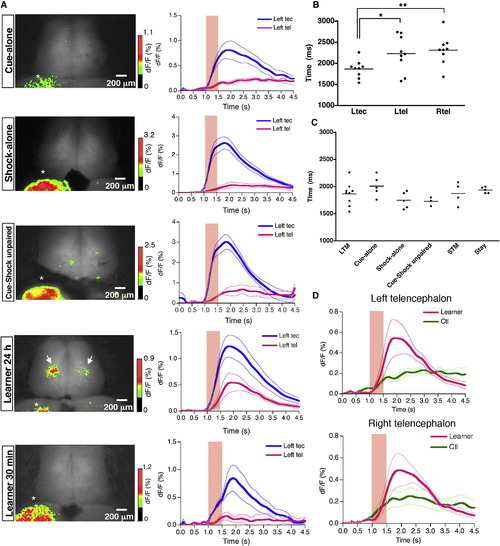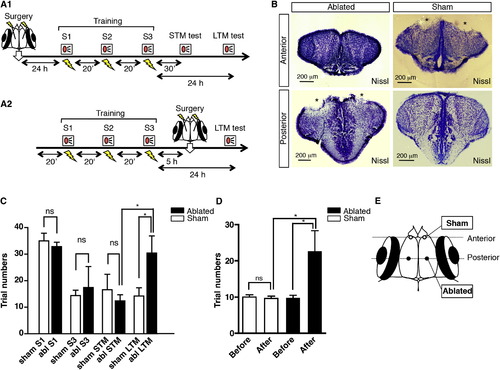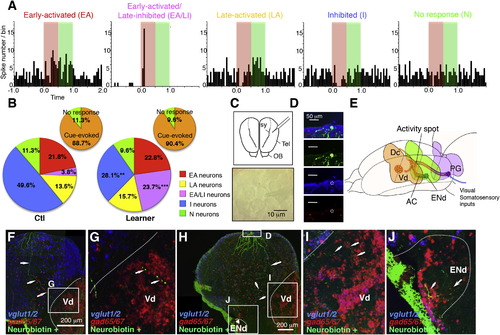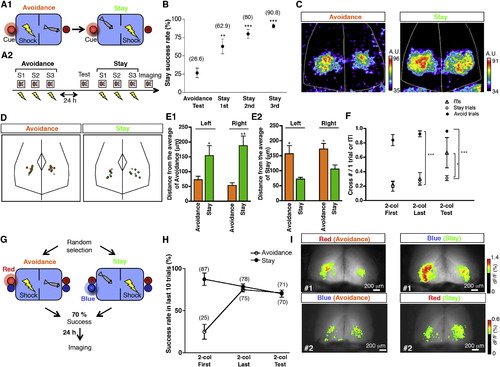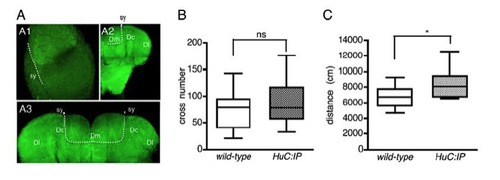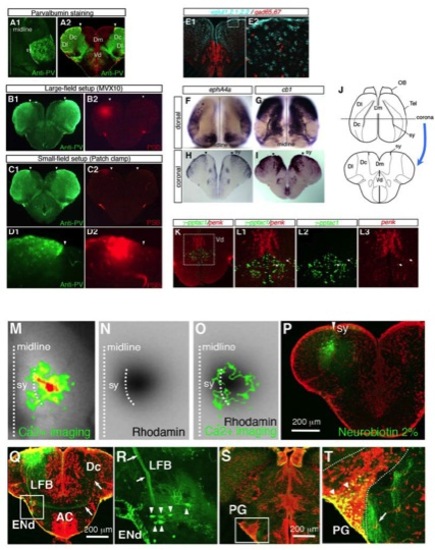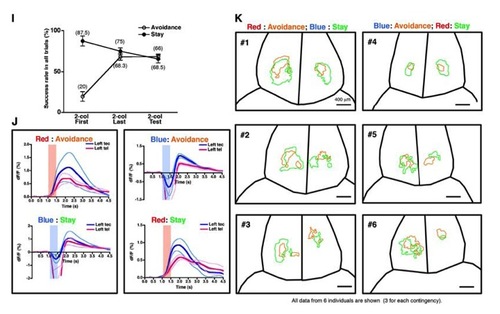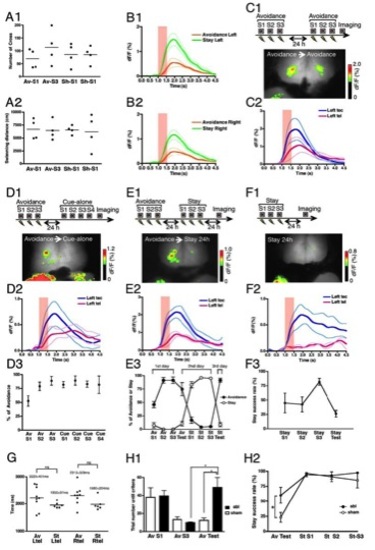- Title
-
Imaging of Neural Ensemble for the Retrieval of a Learned Behavioral Program
- Authors
- Aoki, T., Kinoshita, M., Aoki, R., Agetsuma, M., Aizawa, H., Yamazaki, M., Takahoko, M., Amo, R., Arata, A., Higashijima, S.I., Tsuboi, T., and Okamoto, H.
- Source
- Full text @ Neuron
|
Calcium Signals Encoding Memory Retrieval in Zebrafish Telencephalon (A) Left: example of individual activity pattern for each experimental group. The image was taken at 1 s after the cue presentation. Star indicates the activity in the optic tectum. Arrows indicate the activity spots in the telencephalon specific to the learner fish 24 hr after the training. Right: averaged temporal sequence of fluorescence change of each experimental group in the left optic tectum (blue line, Left tec) and the left telencephalon (pink line, Left tel). The mean ± SEM is plotted. The cue presentation period was indicated with a red shadowed box. Cue-alone, n = 6; shock-alone, n = 4; cue-shock unpaired, n = 5, learner 24 hr, n=7; learner 30 min, n=4. (B) Comparison of the average of the peak time for left tectum (Ltec), left telencephalon (Ltel), and right telencephalon (Rtel) in the learner group. The peak times in the left (2,228 ± 401 ms) and right (2,313 ± 328 ms) telencephalon are significantly later than that in the left tectum (1,864 ± 197 ms). *p < 0.05, **p < 0.01, unpaired t test. There was no significant difference between the peak times in the left and right telencephalon. p = 0.6516, unpaired t test. (C) Comparison of the average of the peak time for left tectum in all experimental conditions including stay task (see Figure 5). LTM, learner imaged 24 hr after the last training; STM, learner imaged 30 min after the last training. LTM (1,864 ± 197 ms) versus cue-alone (2,008 ± 170 ms), p = 0.2308, unpaired t test. LTM versus shock-alone (1,748 ± 135 ms), p = 0.2993, unpaired t test. LTM versus cue-shock unpaired (1,726 ± 65 ms), p = 0.3052, unpaired t test. LTM versus STM (1,875 ± 179 ms), p = 0.9346, unpaired t test. LTM versus stay (1,936 ± 49 ms), p = 0.3604, unpaired t test. (D) Comparison of the averaged temporal sequence of fluorescence change of the telencephalon between the cue-alone group (green line) and the learner group (pink line). The mean ± SEM is plotted. The cue presentation period is indicated with a red shadowed box. See also Movies S3, S4, and S5 and Figure S2. |
|
Lesion of Activated Areas Impairs Retrieval of the Long-Term Stored Avoidance Behavior (A1) Experimental schedule for the ablation before training. On the first day, fish underwent the surgery and were kept overnight for the recovery. On the second day, fish were trained in active avoidance learning as described. The short-term memory (STM) was tested 30 min after the last training session and the long-term memory (LTM) was tested 24 hr after the last training. S1, session 1; S2, session 2; S3, session 3. (A2) Experimental schedule for the ablation after training. Fish were first trained in active avoidance learning as described. Surgery was then conducted at 5 hr after the last training, and a retention test was performed 24 hr after the last training. (B) Representative examples of the activated area-ablated and sham-operated individuals. Section level is indicated in (E). Anterior (sham-operation-level) and posterior (the activity spot-level) sections with Nissl staining are shown in coronal view. Stars indicate the ablated sites. (C) The ablation before training does not affect the acquisition of the learning and STM but does affect the LTM. Columns and bars represent the mean ± SEM, respectively. Sham, n = 5; abl, n = 5. The average trial numbers required to achieve the learning criterion were 35 and 32.8 for sham S1 and abl S1, 14.4 and 17.4 for sham S3 and abl S3, 16.6 and 12.4 for sham STM and abl STM, and 14.2 and 30.4 for sham LTM and abl LTM. Sham S1 versus abl S1, p = 0.2642, unpaired t test. Sham S3 versus abl S3, p = 0.3659, unpaired t test. Sham STM versus abl STM, p = 0.2604, unpaired t test, sham LTM versus abl LTM, *p < 0.05, unpaired t test. abl STM versus abl LTM, *p < 0.05, sham STM versus sham LTM, p = 0.3641, unpaired t test. abl, ablated. (D) The effect of ablation at 24 hr after training on the retrieval of the avoidance behavior. Columns and bars represent the mean ± SEM, respectively. Sham, n = 8; abl, n = 14. The average trial numbers required to achieve the learning criterion were 10 and 9.6 before and after the sham procedure, respectively, and 9.6 and 23.6 before and after ablation, respectively. Sham before versus sham after, p = 0.35, paired t test. Ablated before versus ablated after, *p < 0.05, paired t test. Sham after versus ablated after, *p < 0.05, unpaired t test. (E) Schematic map for the ablation sites. Black circles indicate activity spot ablation sites. White circles indicate sham-operated ablation sites. For calculation of the site, see Experimental Procedures.See also Figure S3. |
|
Electrophysiological, Morphological, and Neurochemical Profiling (A) Representative neural activity for each response class of neuron. A red shadow indicates the 500 ms cue presentation period. A green shadow indicates the following 500 ms postcue presentation period used for the analysis. (B) Learning-dependent changes in the proportion of each type of neurons. The proportion of EA/LI neurons was significantly larger in learner fish (p < 0.001***, χ2 test). The proportion of I neurons was significantly smaller in learner fish (p < 0.01**, χ2 test). EA neurons, ctl, n = 30, learner, n = 26; EA/LI neurons, ctl, n = 5, learner, n = 15; LA neurons, ctl, n = 18, learner, n = 18; I neurons, ctl, n = 65, learner, n = 32; N neurons, ctl, n = 15, learner, n = 11. (C) The recording site was lateral to sy and within the activated area (see Experimental Procedures). Tel, telencephalon; OB, olfactory bulb. Scale bar indicates 10 μm. (D) Cell body of neuron in (G) (the square region indicated as D) showing expression of vglut 1,2.1, 2.2 (blue) but not gad 65,67 (red). Scale bar indicates 50 μm. (E) Schematic diagram showing the connection of the activated area in the dorsal telencephalon with other parts of the brain based on single-cell tracing studies and bulk labeling. The activity spot receives the visual and/or somatosensory inputs from the PG. It projects to the Vd, the presumptive striatum in teleosts, and also toward the contralateral hemisphere passing by the ENd and extending into the AC. There are reciprocal projections between the activated area and the ENd as well as the PG, indicated by bidirectional arrows. See Supplemental Information for details of the tracing study. Anterior is to the left. Dorsal is toward the top. (F) An example of a labeled neuron (green) projecting to the dorsal nucleus of the ventral telencephalic area (Vd). Arrows show the trajectory of the projecting axon-like structure. The cell body was inadvertently removed during histochemistry processing. Scale bar indicates 200 μm. (G) Magnified view of the square region in (F) (indicated as G) showing the extended projection within the Vd. vglut 1,2.1, 2.2 (blue) and gad 65,67 (red) were costained by in situ hybridization. Arrows show the terminated axon-like projection within the Vd (outlined with a white dotted line). (H) Example of a labeled neuron (green) projecting toward the entopeduncular nucleus dorsal part (ENd) as well as the Vd. Arrows indicate the putative axonal projection and an arrowhead indicates the extended projection within the ENd. vglut 1,2.1,2.2 (blue) and gad 65,67 (red) were costained by in situ hybridization. Scale bar indicates 200 μm. (I) Higher magnification of the square region in (H) (indicated as I) around the Vd. The arrows show the bifurcated axon branches entering the Vd region. A white dotted line outlines the Vd. (J) Higher magnification of the square region in (I) (indicated as J) around the ENd. The arrows show the passing by axonal projection. A white dotted line outlines the ENd. See also Figure S4. |
|
Zebrafish Learn and Encode the Behavioral Rule Change (A1) In the original active avoidance paradigm (avoidance task), fish had to swim into the other compartment to avoid the punishment upon the cue presentation. After a change in the learning contingency (stay task), fish had to stay in the same compartment with the cue turned on to avoid the punishment. (A2) Experimental schedule. On the first day, fish were trained for the avoidance task. Then, at 24 hr after the last training, fish were first tested for their retrieval of the avoidance behavior trained in the avoidance task, rested for 20 min, and then trained for the stay task. Imaging was performed 30 min after the last stay training. (B) The percentage of successful trials for stay training out of the total trial numbers was plotted as stay success rate (percentage). Dots and bars represent the mean ± SEM, respectively. Stay success rate increased as stay training sessions were repeated and reached over 80% after three sessions. The stay success rate averages were as follows: avoidance test = 26.6%, stay first session = 62.9%, stay second session = 80%, stay third session = 90.8%. n = 6. Statistical analysis was performed by repeated-measures one-way ANOVA and Bonferroni?s multiple comparison test. Avoidance test versus stay 1st, **p < 0.01; avoidance test versus stay 2nd, ***p < 0.001; avoidance test versus stay 3rd, ***p < 0.001. Stay 1st: stay task first session, stay 2nd: stay task second session, stay 3rd: stay task third session. (C) Representative individual activity maps for the avoidance and stay task memory retrieval. The activity pattern for stay is broader than for avoidance. (D) Distribution of the activity centers of individuals trained in the schedule as in (A2). Orange circles indicate activity centers for the avoidance task (n = 7) and green circles indicate activity centers for the stay task (n = 6). The orange and green crosses indicate the average points for the avoidance and stay activity centers, respectively. (E1 and E2) Avoidance task clusters of activity centers calculated from individuals trained in the schedule as in (A2) are significantly shifted from stay task clusters. Columns and bars represent the mean ± SEM, respectively. Avoidance task, n = 7; stay task, n = 6. (E1) Distances from the average point of the activity centers for the avoidance task to each activity center for the avoidance task and stay task were calculated for each hemisphere. *p < 0.05 and **p < 0.01, unpaired t test. (E2) Distances from the average point of activity centers for the stay task to each activity center for avoidance task and stay task were calculated for each hemisphere. *p < 0.05, unpaired t test. (F) Number of crossing the hurdle during two-color conditioning and test was plotted (cross-number/1 trial or ITI). Dots and bars represent the mean ± SEM, respectively. n = 8. *p < 0.05, ***p < 0.001, two-way ANOVA, Bonferroni?s post test. 2-col first, two-color conditioning first training session; 2-col last, two-color conditioning last training session; 2-col Test, two-color conditioning test session. The open triangle indicates cross-numbers during ITIs, the open circle indicates cross-numbers during stay task trials, and the filled circle indicates cross-numbers during avoidance task trials. (G) In two-color conditioning paradigm, the main program randomly selects one of the two tasks, avoidance and stay tasks. When the success rate becomes above 70% for both tasks, the training was stopped. Twenty-four hours after the last training, the calcium imaging was performed. Either of red LED-avoidance task/blue LED-stay task contingency or blue LED-avoidance task/red LED-stay task contingency was adopted. The same contingency was applied to one fish throughout the training period. (H) The percentage of successful trials for each task in last ten trials. Open circle indicates the percentage of avoidance and the black filled circle indicates the percentage of stay. Circles and bars represent the mean ± SEM, respectively. The success rate averages were avoidance first training = 25%, stay first training = 87.3%, avoidance last training = 75%, stay last training = 78.7%, avoidance test = 71.1%, and stay test = 70.2%. n = 8. (I) The representative activity pattern for each contingency. Fish 1 was trained with red LED-avoidance task/blue LED-stay task contingency. Fish 2 was trained with blue LED-avoidance task/red LED-stay task contingency. Scale bars indicate 200 μm. See also Figure S5 and Movie S6. |
|
(A) Expression of inverse pericam (IP) in the telencephalon of adult HuC:IP transgenic fish. |
|
(A-D) The activated areas observed in the large-field and the small-field imaging setups coincide. |
|
(A1, A2) Behaviors of fish which were trained by the Avoidance task then exposed to the electric shocks alone during adaptation periods. |

